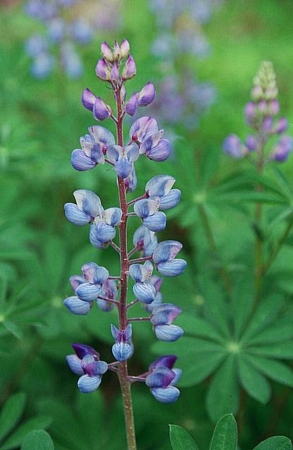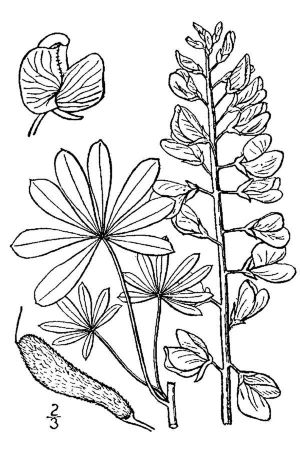
|

|
| Photo
by Renee Brecht |
Britton and Brown. See
credits below. |
| Botanical name: |
Lupinus perennis
|
| Common
name: |
Wild lupine
|
| Synonomy |
n/a |
| Group: |
Dicot |
| Family: |
Fabaceae |
| Growth
Type: |
Forb/herb |
| Duration: |
Perennial |
| Plant
height: |
1'-2'
|
| Flower
color: |
purplish-blue |
| Flower
size: |
clustered on spikes of 4"-10"
|
| Flowering/fruiting time |
Fl. early May to early June; fr:
early June to early July.
|
| Habitat: |
Open sandy ground and along the edges
of woods
|
| Range in
New Jersey: |
A few stations in northern counties,
but mainly a plant of the coastal plain and Middle district, though
often found in the Pine Barrens and Cape May district.
|
| Heritage ranking if any |
S3 |
| Misc.: |
Leaves divided into 7-11 finy, hairy
leaflets, wheel-like.
In Demographic
and genetic factors affecting population viability of Lupinus perennis,
an indicator species of Oak Savanna., Mitchell and Michaels note that "small and sparse populations often have low reproductive success,
indicating that fragmentation of populations by human activities may
prevent populations from being self-sustaining.".
Lupinus perennis is
the larval host plant for both Karner Blue butterfly
(Lycaeides melissa sub. samuelis) Frosted Elfin butterfly (Callophrys
irus) .
The plant was once thought to deplete or "wolf" the mineral content of
the soil; hence the genus name derived from the Latin lupus ("wolf").
Actually the plant and all the family enhances soil fertility by fixing
atmospheric nitrogen into a useful form. |
Not sure what a word means? Use Answers.com:
|
| Sources |
|
|
Copyright 2008
Citizens United
to Protect the Maurice River & its Tributaries. All
rights reserved.
Send
comments, suggestions, and error reports to NJBotany
|